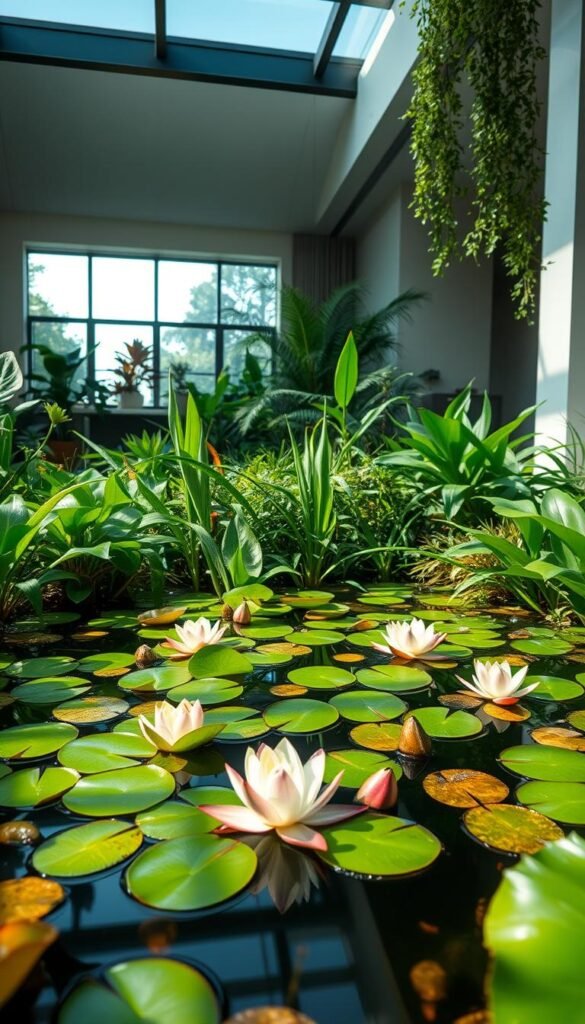Imagine transforming any corner of your home into a relaxing retreat using flowing water and vibrant greenery. Contrary to popular belief, you don’t need a pond or expert skills to craft stunning displays. With simple containers and the right greenery, anyone can design a mini oasis that soothes the senses.
These living features do more than beautify your space. They naturally humidify rooms, filter air, and create moments of calm in busy days. Whether you choose a tabletop bowl or repurpose an old fountain, water-based displays adapt effortlessly to apartments, offices, or sunrooms.
This guide reveals how easy it is to start. You’ll learn which species thrive in home environments and how to arrange them for visual impact. Discover creative ways to use glass vases, ceramic pots, or even terrariums as foundations for your designs.
Ready to turn everyday containers into eye-catching natural art? Let’s explore how flowing water and leafy textures can become your home’s most therapeutic focal area.
Understanding Indoor Water Gardens and Their Benefits
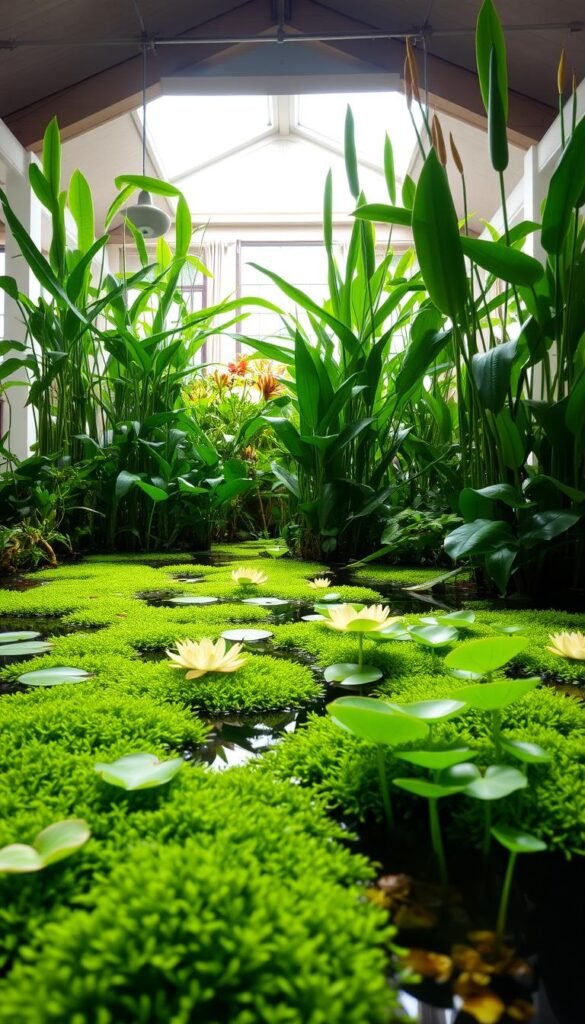
Bringing nature indoors doesn’t require complicated setups or large outdoor spaces. A water garden designed for interior spaces combines flowing elements with greenery to create living art. These compact ecosystems fit seamlessly into modern lifestyles while offering surprising advantages.
What Is an Indoor Water Garden?
Think of it as a self-contained world where moisture-loving species flourish. Unlike outdoor ponds, these setups use containers like glass bowls or ceramic planters. They range from desk-friendly sizes to room-dividing installations, adapting to your space and style.
Year-round enjoyment sets them apart. You’ll avoid seasonal limitations while maintaining cleaner conditions. Closed environments mean fewer pests and algae compared to exterior versions.
Key Benefits of Using Aquatic Plants at Home
These green companions work overtime. Their leaves release oxygen and absorb pollutants, acting as natural air purifiers. During dry winters, they add moisture to combat stuffy heating systems.
The psychological perks matter too. Gentle water sounds and leaf movements create calming rhythms. Studies show such elements reduce stress hormones by up to 15% in enclosed spaces.
Maintenance stays simple with smart design. Most setups need weekly checks at most. You’ll spend less time pruning than with traditional houseplants while enjoying continuous visual rewards.
Selecting the Ideal Container and Location
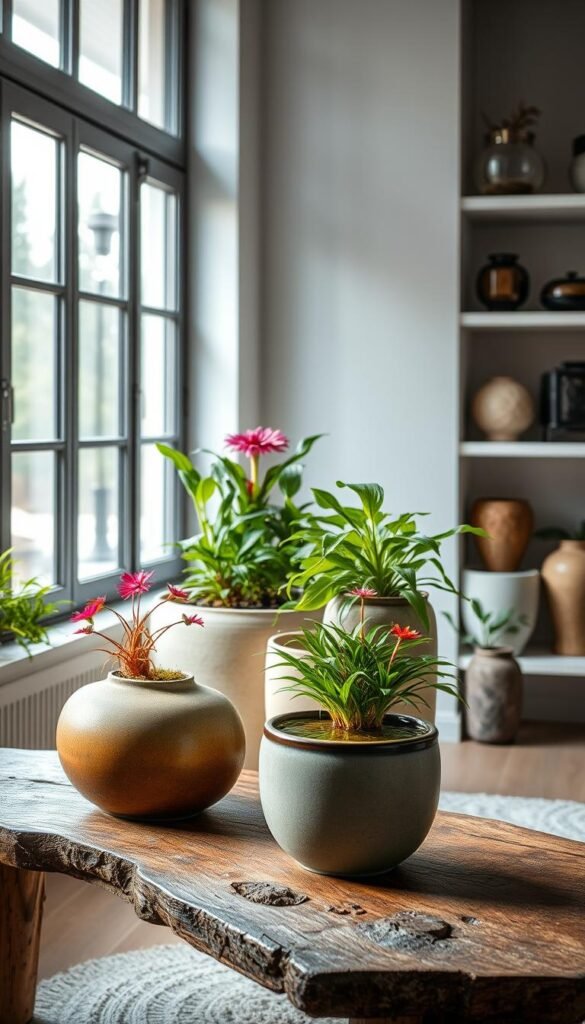
Your container choice shapes your garden’s success as much as the greenery itself. Let’s explore how to match vessels and spaces to your lifestyle while keeping greenery thriving.
Choosing the Right Container for Your Setup
Start with what you already own. Glass bowls, wide vases, or even repurposed terrariums work beautifully. Depth matters most—shallow containers suit surface-loving species, while deeper ones let roots spread. Aim for at least 6 inches of water depth for flexibility.
Clear materials help monitor root health and water clarity. If mixing species, ensure your container’s width allows proper spacing. For budget-friendly ideas, check our guide to colorful container gardening using everyday items.
Optimizing Light and Placement
Most species crave bright, indirect light. East-facing windows offer gentle morning rays, while west-facing spots provide softer afternoon sun. Rotate your container weekly to prevent lopsided growth.
Avoid high-traffic areas where splashes might occur. Kitchens and bathrooms often work well—they’re humid and near natural light sources. If your space lacks sunlight, LED grow lights placed 12 inches above the water can fill the gap.
Aquatic Plants for an Indoor Water Garden: Creating a Serene Focal Point
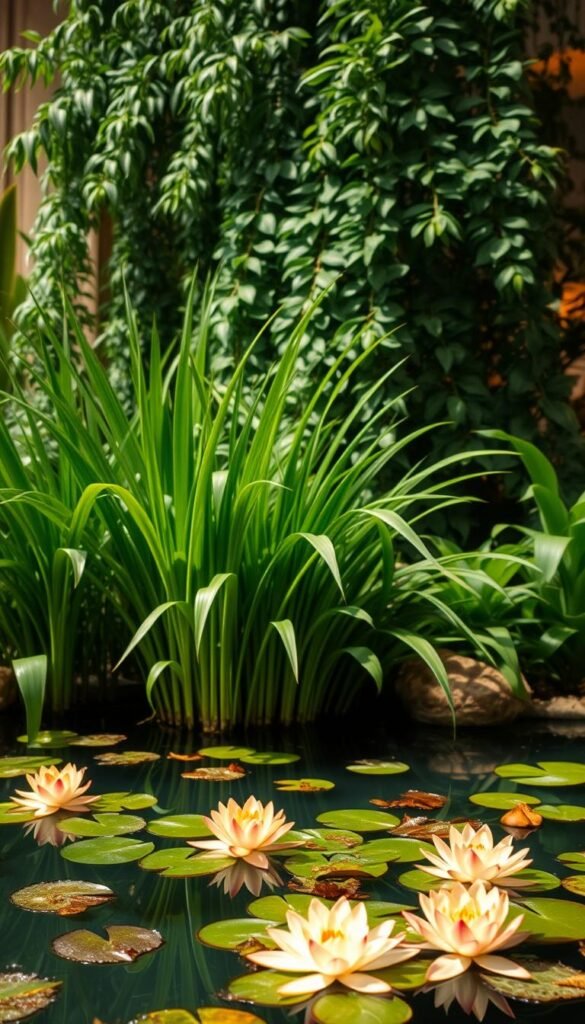
Your living space becomes a living ecosystem when you combine different types of moisture-loving greenery. Each category plays specific roles in maintaining balance and beauty. Let’s break down the key players and how to keep them thriving.
Essential Plant Categories Explained
Four main groups work together in harmony. Floating varieties like dwarf water lilies create natural sunshades with their broad leaves. Submerged oxygenators such as anacharis act as natural filters, bubbling oxygen into the water.
| Type | Examples | Key Benefits |
|---|---|---|
| Floating | Water lettuce, Frogbit | Reduce algae, add texture |
| Oxygenating | Hornwort, Eelgrass | Filter impurities, boost oxygen |
| Marginal | Cattails, Arrowhead | Prevent erosion, vertical interest |
| Bog | Pitcher plants, Iris | Unique shapes, soil stabilization |
Keeping Your Green Community Healthy
Rotate containers weekly for even light exposure. Use aquatic-safe fertilizer tablets every 6-8 weeks during active growth periods. Trim yellowing leaves promptly to prevent decay.
Watch for these signs of trouble:
- Cloudy water (needs filter check)
- Stunted growth (test pH levels)
- Leaf holes (inspect for snails)
Change 25% of the water monthly using room-temperature liquid. Wipe container walls during changes to maintain crystal-clear views of your underwater world.
Exploring Plant Varieties: Floating, Oxygenating, and Marginal Options
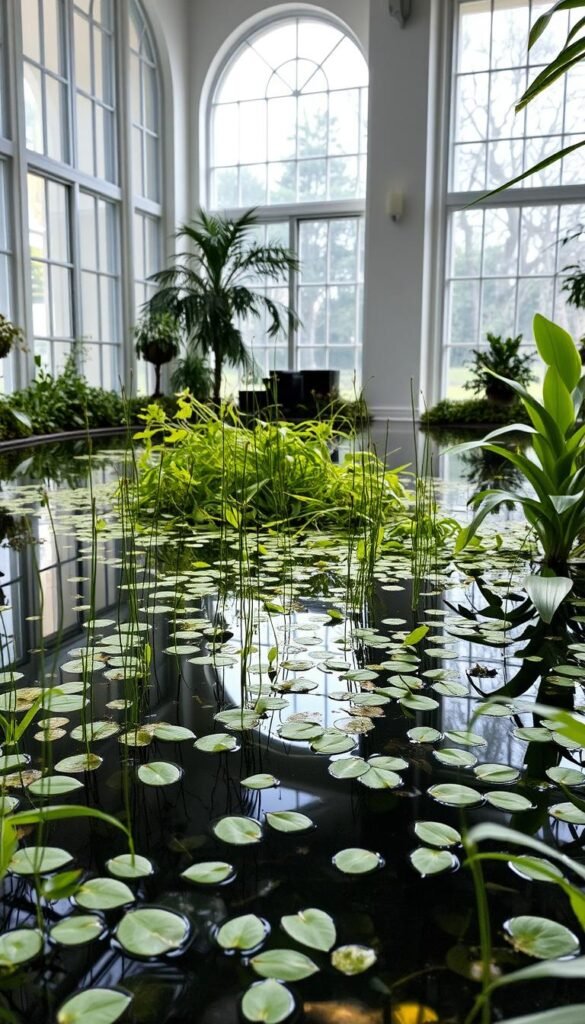
Your home’s atmosphere transforms when you introduce living elements that purify and beautify. Each category serves unique roles—some clean while others dazzle. Let’s dive into the best performers for clarity and visual appeal.
Floating and Oxygenating Plants for Clear, Healthy Water
Water lettuce (Pistia stratiotes) floats like living lace, its feathery roots absorbing excess nutrients. This natural shade provider slows algae growth while sheltering beneficial microorganisms. Pair it with hornwort—a submerged oxygenator that bubbles life into your setup through vigorous photosynthesis.
Miniature water lilies thrive in containers, their broad leaves stabilizing temperatures. For crystal-clear liquid, add anacharis. This fast-growing filter starves unwanted algae by hogging nutrients. Keep these helpers happy with 4+ hours of indirect light.
Marginal and Bog Plants for Decorative Edges
Cattails bring vertical drama when planted along container edges. Their iconic brown spikes add texture without overwhelming small spaces. Water iris varieties steal the show with sword-shaped leaves and purple blooms, perfect for small water features.
Delicate water plantain softens hard edges with dainty pink flowers. These margin-dwellers need shallow depths—just 2-3 inches of submerged roots. Rotate their pots weekly to prevent leaning toward light sources.
Step-by-Step Guide to Setting Up Your Indoor Water Garden
Building your miniature ecosystem takes just an afternoon with the right approach. Follow these simple stages to ensure your greenery thrives while keeping maintenance minimal.
Preparing Your Container and Base Layer
Start with a clear glass container that matches your space’s style. Inspect it for hairline cracks—even tiny flaws can leak over time. Rinse decorative stones under running water until the runoff turns clear, removing dust and debris.
Create a 1-2 inch base layer at the bottom. This anchors your greenery and adds visual depth. Smooth the stones evenly to prevent uneven plant placement later.
Planting Techniques and Water Management
Position moisture-loving species gently atop the stone bed. Nestle their roots firmly between rocks for stability. Leave space between plants to avoid overcrowding as they grow.
Pour distilled water slowly along the container’s side until it covers the roots. Maintain a half-inch gap at the top to prevent spills. This pure liquid prevents mineral buildup, keeping your system crystal clear without chemical additives.
Pro tip: Place a saucer underneath if using porous stones. It catches stray droplets while blending seamlessly with your décor.

